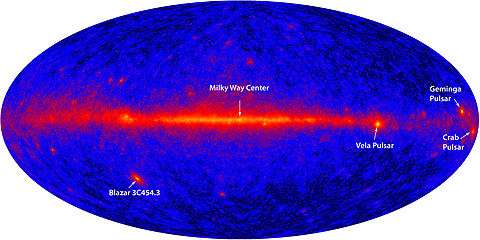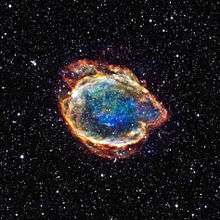Vela Supernova Remnant
The Vela supernova remnant is a supernova remnant in the southern constellation Vela. Its source Type II supernova exploded approximately 11,000–12,300 years ago (and was about 800 light-years away). The association of the Vela supernova remnant with the Vela pulsar, made by astronomers at the University of Sydney in 1968,[2] was direct observational evidence that supernovae form neutron stars.
| Diffuse nebula | |
|---|---|
| supernova remnant | |
.jpg) The northern portion of the Vela Supernova Remnant Credit: Harel Boren | |
| Observation data: J2000.0 epoch | |
| Right ascension | 08h 35m 20.66s |
| Declination | −45° 10′ 35.2″ |
| Distance | 815±98[1] ly (250±30 pc) |
| Apparent magnitude (V) | 12 |
| Apparent dimensions (V) | 8 degrees (approx.) |
| Constellation | Vela |
| Designations | Vela XYZ, Gum 16, SNR G263.9-03.3, 1E 0840.0-4430, RE J083854-430902 |
The Vela supernova remnant includes NGC 2736. It also overlaps the Puppis A supernova remnant, which is four times more distant. Both the Puppis and Vela remnants are among the largest and brightest features in the X-ray sky.
The Vela supernova remnant (SNR) is one of the closest known to us. The Geminga pulsar is closer (and also resulted from a supernova), and in 1998 another near-Earth supernova remnant was discovered, RX J0852.0-4622, which from our point of view appears to be contained in the southeastern part of the Vela remnant. One estimate of its distance puts it only 200 parsecs away (about 650 ly), closer than the Vela remnant, and, surprisingly, it seems to have exploded much more recently, in the last thousand years, because it is still radiating gamma rays from the decay of titanium-44. This remnant was not seen earlier because in most wavelengths, it is lost because of the presence of the Vela remnant.[3]
 Position of Vela in the Milky Way
Position of Vela in the Milky Way
References
- Cha, Alexandra N.; et al. (1999). "The Distance to the Vela Supernova Remnant". The Astrophysical Journal Letters. 515: L25–L28. arXiv:astro-ph/9902230. Bibcode:1999ApJ...515L..25C. doi:10.1086/311968.
- Large, M. I.; et al. (1968). "A Pulsar Supernova Association?". Nature. 20 (5165): 340. Bibcode:1968Natur.220..340L. doi:10.1038/220340a0.
- Iyudin, A. F.; et al. (November 1998). "Emission from 44Ti associated with a previously unknown Galactic supernova". Nature. 396 (6707): 142–144. Bibcode:1998Natur.396..142I. doi:10.1038/24106.
External links
- "NAME Vela XYZ". SIMBAD. Centre de données astronomiques de Strasbourg.
- The Vela Supernova Remnant on WikiSky: DSS2, SDSS, GALEX, IRAS, Hydrogen α, X-Ray, Astrophoto, Sky Map, Articles and images
- NASA Astronomy Picture of the Day: Vela Supernova Remnant (1 January 2015)
- NASA Astronomy Picture of the Day: Vela Supernova Remnant (6 March 2008)
- NASA Astronomy Picture of the Day: Vela Supernova Remnant in Visible Light (13 February 2007)
- NASA Astronomy Picture of the Day: Filaments of the Vela Supernova Remnant (1 October 2013)
- Gum Nebula (annotated)
- Bill Blair's Vela Supernova Remnant page

